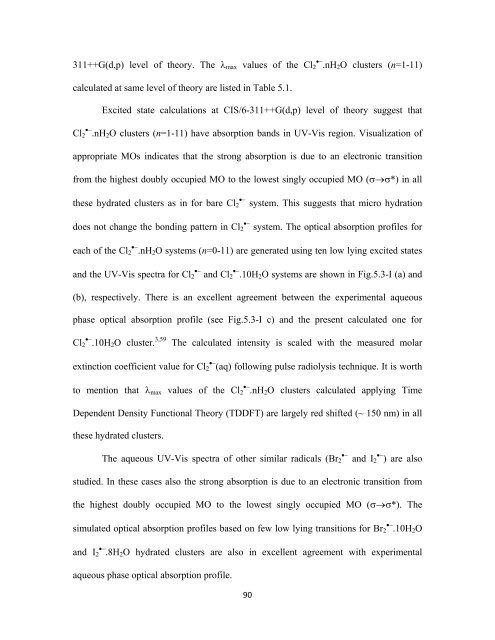CHEM01200604005 A. K. Pathak - Homi Bhabha National Institute
CHEM01200604005 A. K. Pathak - Homi Bhabha National Institute
CHEM01200604005 A. K. Pathak - Homi Bhabha National Institute
You also want an ePaper? Increase the reach of your titles
YUMPU automatically turns print PDFs into web optimized ePapers that Google loves.
311++G(d,p) level of theory. The λ max values of the Cl •− 2 .nH 2 O clusters (n=1-11)<br />
calculated at same level of theory are listed in Table 5.1.<br />
Excited state calculations at CIS/6-311++G(d,p) level of theory suggest that<br />
Cl •− 2 .nH 2 O clusters (n=1-11) have absorption bands in UV-Vis region. Visualization of<br />
appropriate MOs indicates that the strong absorption is due to an electronic transition<br />
from the highest doubly occupied MO to the lowest singly occupied MO (σ→σ*) in all<br />
these hydrated clusters as in for bare Cl •− 2 system. This suggests that micro hydration<br />
does not change the bonding pattern in Cl •− 2 system. The optical absorption profiles for<br />
each of the Cl •− 2 .nH 2 O systems (n=0-11) are generated using ten low lying excited states<br />
and the UV-Vis spectra for Cl •− 2 and Cl •− 2 .10H 2 O systems are shown in Fig.5.3-I (a) and<br />
(b), respectively. There is an excellent agreement between the experimental aqueous<br />
phase optical absorption profile (see Fig.5.3-I c) and the present calculated one for<br />
Cl 2 •− .10H 2 O cluster. 3,59<br />
The calculated intensity is scaled with the measured molar<br />
extinction coefficient value for Cl •− 2 (aq) following pulse radiolysis technique. It is worth<br />
to mention that λ max values of the Cl •− 2 .nH 2 O clusters calculated applying Time<br />
Dependent Density Functional Theory (TDDFT) are largely red shifted (~ 150 nm) in all<br />
these hydrated clusters.<br />
The aqueous UV-Vis spectra of other similar radicals (Br •− 2 and I •− 2 ) are also<br />
studied. In these cases also the strong absorption is due to an electronic transition from<br />
the highest doubly occupied MO to the lowest singly occupied MO (σ→σ*). The<br />
simulated optical absorption profiles based on few low lying transitions for Br •− 2 .10H 2 O<br />
and I •− 2 .8H 2 O hydrated clusters are also in excellent agreement with experimental<br />
aqueous phase optical absorption profile.<br />
90
















